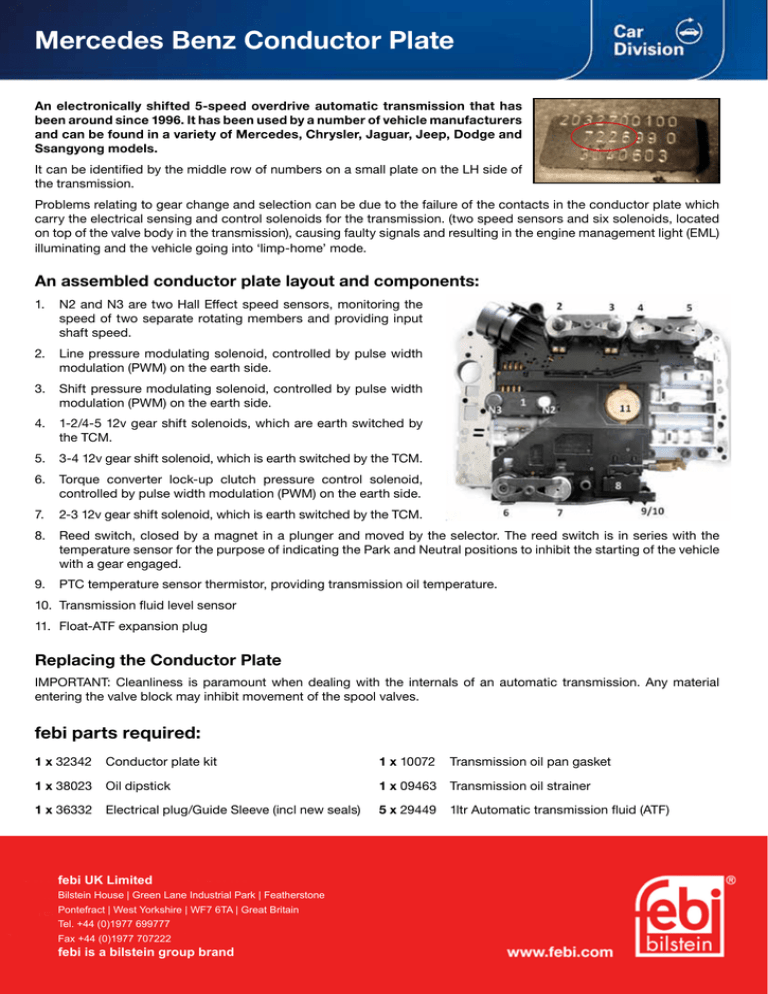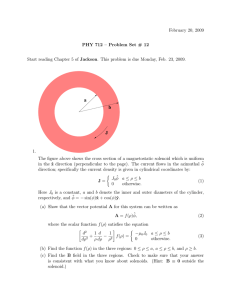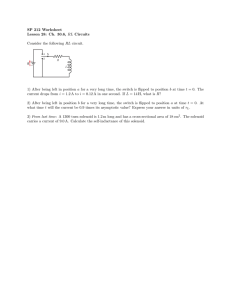Mercedes Automatic Transmission Conductor Plate
advertisement

Mercedes Benz Conductor Plate An electronically shifted 5-speed overdrive automatic transmission that has been around since 1996. It has been used by a number of vehicle manufacturers and can be found in a variety of Mercedes, Chrysler, Jaguar, Jeep, Dodge and Ssangyong models. It can be identified by the middle row of numbers on a small plate on the LH side of the transmission. Problems relating to gear change and selection can be due to the failure of the contacts in the conductor plate which carry the electrical sensing and control solenoids for the transmission. (two speed sensors and six solenoids, located on top of the valve body in the transmission), causing faulty signals and resulting in the engine management light (EML) illuminating and the vehicle going into ‘limp-home’ mode. An assembled conductor plate layout and components: 1.N2 and N3 are two Hall Effect speed sensors, monitoring the speed of two separate rotating members and providing input shaft speed. 2.Line pressure modulating solenoid, controlled by pulse width modulation (PWM) on the earth side. 3.Shift pressure modulating solenoid, controlled by pulse width modulation (PWM) on the earth side. 4.1-2/4-5 12v gear shift solenoids, which are earth switched by the TCM. 5.3-4 12v gear shift solenoid, which is earth switched by the TCM. 6.Torque converter lock-up clutch pressure control solenoid, controlled by pulse width modulation (PWM) on the earth side. 7.2-3 12v gear shift solenoid, which is earth switched by the TCM. 8.Reed switch, closed by a magnet in a plunger and moved by the selector. The reed switch is in series with the temperature sensor for the purpose of indicating the Park and Neutral positions to inhibit the starting of the vehicle with a gear engaged. 9. PTC temperature sensor thermistor, providing transmission oil temperature. 10. Transmission fluid level sensor 11. Float-ATF expansion plug Replacing the Conductor Plate IMPORTANT: Cleanliness is paramount when dealing with the internals of an automatic transmission. Any material entering the valve block may inhibit movement of the spool valves. febi parts required: 1 x 32342 Conductor plate kit 1 x 10072 Transmission oil pan gasket 1 x 38023 Oil dipstick 1 x 09463 Transmission oil strainer 1 x 36332 Electrical plug/Guide Sleeve (incl new seals) 5 x 29449 1ltr Automatic transmission fluid (ATF) febi UK Limited Bilstein House | Green Lane Industrial Park | Featherstone Pontefract | West Yorkshire | WF7 6TA | Great Britain Tel. +44 (0)1977 699777 Fax +44 (0)1977 707222 febi is a bilstein group brand 02 Blue Print Diagnosis In the first instance use a diagnostic scan tool to check for fault codes. All of the sensing and transmission control is confined to the valve body conductor plate and the TCM. Any failure of the devices on the conductor plate will produce fault codes. e.g. OBD codes P0753-748 relate to the Solenoids, OBD code P0715 relate to the speed sensors There are no pressure outlets, so hydraulic pressures cannot be monitored and there are no pressure transducers in the transmission. The pressure data you read on your scan tool is estimated from the PWM applied to the three modulating solenoids. Further checking of the conductor plate components can also be carried out at the conductor plate terminal, while either disconnected or back-probed whist connected. This can also be done at the TCM with appropriate TCM terminal pin data. Conductor plate terminals Component Value 1 2 and 6 3 4 and 12 5not used 6 7 8 and 6 9 10 and 6 11 and 6 12 RPM signal N3 Line pressure modulating solenoid RPM signal N2 ATF Temp sensor/inhibitor Not used Solenoid voltage supply RPM Sensor voltage supply 2-3 shift solenoid 3-4 shift solenoid Shift pressure modulating solenoid Lock up clutch modulating solenoid Sensor ground Square wave (2nd gear) 5.5Ω Square wave (‘P’ position) 800-1200Ω at 20°C in ‘D’ or ‘R’ Not used Battery voltage 4-8 Volts 4.5 Ω 4.5Ω 5.5Ω 2.7Ω 0.01 volts or less 13 1-2/4-5 shift solenoid 4.5Ω 1 2 6 3 7 12 6 4.7 - 5.3 Ohms Line Pressure Modulator Solenoid Shift Pressure Modulator Solenoid 2 1 4 Ohms 1-2 / 4-5 Shift Solenoid 4 Ohms 3-4 Shift Solenoid 3 4 5 4.7 - 5.3 Ohms 9 10 9 7 8 13 N2 Conductor Plate Terminal + - N2 12 11 N3 10 13 Speed Sensors 4 Reed Switch N3 2.35 - 2.65 Ohms 4 Ohms Torque Converter Lock Up Clutch Solenoid 2-3 Shift Solenoid N Magnet on Plunger Closes Starter Interlock (Reed) Switch in Drive or Reverse ‘O’ Ring 11 S Thermistor Monitors Trans Temp. in Drive and Reverse only 8 ElectroHydraulic Connector Pinout Check the Automatic transmission level It is prudent to check Automatic transmission level before you start so you will have a better idea of how much fluid you will need to complete the job. Very few 722.6 applications are fitted with an ATF fluid level dipstick. The dipstick is available from febi – part number 38023. Remove the red locking tab on the transmission filler tube and remove the plug. The dipstick is around one metre long and is pushed into the transmission dipstick tube until it touches the bottom of the sump pan. There will still be some of the dipstick sticking out of the filler tube. The transmission fluid has a very high rate of volumetric thermal expansion so there are two marks on the dipstick - a lower mark for measuring at 25°C and a higher mark for measuring at 80°C. With the engine warm use the scan tool to check the transmission temperature. The transmission must be in ‘D’ or ‘R’ to close the reed switch in the transmission fluid temperature sensor. In other positions the value defaults to coolant temperature. Take a measurement with the engine at idle and the fluid temperature at 80°C Removal of the Conductor Plate • • • • • • • • • • • • • • • • • First drain the Automatic Transmission Fluid (ATF) into a clean receptacle which is best done with the transmission warm. Measure the quantity and check the fluid for condition and debris. Further dismantling is best done once the transmission has cooled to ambient temperature. Remove the cover on the harness plug. Turn the lug on the tan collar anticlockwise - it will click and then jack-out the 13 pin harness plug. In the centre of the plug is a 7mm bolt. Undo the bolt and then prise out the guide sleeve. Note: The guide sleeve seals are a common source of transmission oil leaks. The febi sleeve includes new seals. Refit the sump drain plug. Support the sump pan, undo the 6 torx bolts and sprags (spacers) and lower the sump pan into a drain receptacle. Note: There will still be fluid in the sump pan and fluid draining from the transmission. There is likely to be a fine dark grey film in the sump pan which is perfectly normal. Inspect the sump magnet for metal pieces indicating more serious mechanical damage. Clean the sump pan and magnet. Remove the oil strainer. Identify and remove the 10 torx screws holding the valve body to the transmission. Be warned that the valve body is reasonably heavy. Remove the valve body, paying close attention to the inhibitor plunger. Inspect the drained transmission fluid. Darkening of the ATF and the smell of burning may indicate heavy clutch wear/slip. febi UK Limited Bilstein House | Green Lane Industrial Park | Featherstone Pontefract | West Yorkshire | WF7 6TA | Great Britain Tel. +44 (0)1977 699777 Fax +44 (0)1977 707222 febi is a bilstein group brand 04 Blue Print • If the ATF has a pink colour or frothing this could indicate cross contamination with coolant. • There have been known cases where coolant enters the transmission via small perforations in the heat exchanger. • There are proprietary glycol testers which will indicate coolant contamination. Disassembly of the Conductor Plate • • • • • • • Work on a clean prepared surface. Remove the plastic solenoid covers from the valve body conductor plate (if fitted) and then remove the 3 torx bolts that secure the springs that retain the solenoids. The solenoids can now be carefully removed. Ensure that you note the position of each solenoid so that they are fitted to the new conductor plate in exactly the same positions. The shift solenoids do not have O-rings, whilst the pressure modulating solenoids have two. Remove the conductor plate from the valve body. Inspect the O-rings and the ports into which whey fit and inspect the port filters for debris. Check the resistance of the solenoids (see Conductor plate terminal diagrams) and inspect for corrosion. Re-assembly of the Conductor Plate • Position the new conductor plate onto the valve body. • There are two locating tabs that will snap into position. • Lubricate the O-rings and push the solenoids into their correct ports while aligning the contacts. • Refit the solenoid retaining springs and torx bolts and tighten to 8Nm. • Refit the plastic solenoid covers • Wipe the mating surfaces between the valve body and transmission with a clean lint-free cloth and refit the valve body locating the selector plunger on the selector sector. • Tighten the valve body retaining bolts to 8Nm. • Lubricate the new strainer O-ring and fit the new oil strainer. Be sure the barbs on the strainer fit into the slot in the valve body. • Lubricate and fit the new sump pan gasket and fit the sump pan to the transmission. • Tighten the bolts to 8Nm. • Tighten the drain plug to the correct torque. The conductor plate is connected to the outside of the transmission by a guide bush which is sealed inside the conductor plate and the transmission casing by two O-rings. Lubricate the guide bush O-rings and align the holes in the guide bush with the pins in the conductor plate and push into place. Tighten the 7mm bolt to 2.5 Nm Refit the harness plug turning the tan collar clockwise until you feel resistance, then turn it a further 30° until you feel it click into its locked position. Re-Filling ATF Measure the ATF you have removed to get some idea of how much you need to replace. You will need to buy about 5 litres of the correct grade ATF. (febi part number 29449) •Replenish the oil through the dipstick/filler tube using a clean funnel or filler pipe. Fill with just less than the quantity you removed earlier. •Start the engine and let it idle for 2 minutes. •Move the selector lever through the different positions, resting for 10 seconds in each position.This will fill the clutches with ATF and expunge any air. • Add fluid until it reaches the upper dipstick level. •Replace the filler plug. A replacement seal is available from the manufacturer if required. Now clear down any fault codes using a diagnostic tool and road test the vehicle, checking for correct operation of the transmission. Re-check for any fault codes after the road test. Additional useful information: Guide Sleeve Seals: The conductor plate is connected to the outside of the transmission by a guide sleeve which is sealed inside the conductor plate and the transmission casing by O-rings. A failure of these rings, as well as a visible oil leak, can actually allow oil to enter the harness plug and metal contaminants suspended in the ATF can cause short circuits. The new febi guide bush is modified with black O-rings to prevent this from re-occurring. febi UK Limited Bilstein House | Green Lane Industrial Park | Featherstone Pontefract | West Yorkshire | WF7 6TA | Great Britain Tel. +44 (0)1977 699777 Fax +44 (0)1977 707222 febi is a bilstein group brand July 2013 05


